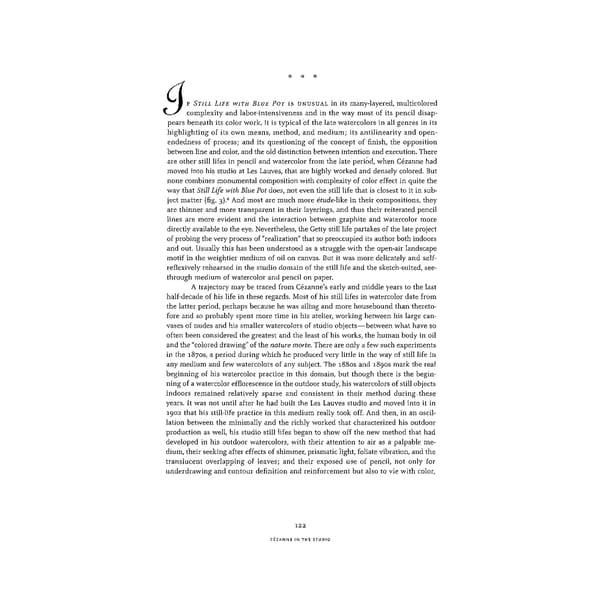F STILL LIFE WITH BLUE POT is UNUSUAL in its many-layered, multicolored I complexity and labor-intensiveness and in the way most of its pencil disap- pears beneath its color work, it is typical of the late watercolors in all genres in its highlighting of its own means method, and medium; its antilinearity and open- ; endedness of process; and its questioning of the concept of finish, the opposition between line and color, and the old distinction between intention and execution. There are other still lifes in pencil and watercolor from the late period, when Cezanne had moved into his studio at Les Lauves, that are highly worked and densely colored. But none combines monumental composition with complexity of color effect in quite the way that Still Life with Blue Pot does, not even the still life that is closest to it in sub- ject matter (fig. 3).6 And most are much more etude-like in their compositions, they are thinner and more transparent in their layerings, and thus their reiterated pencil lines are more evident and the interaction between graphite and watercolor more directly available to the eye. Nevertheless, the Getty still life partakes of the late project of probing the very process of "realization" that so preoccupied its author both indoors and out. Usually this has been understood as a struggle with the open-air landscape motif in the weightier medium of oil on canvas. But it was more delicately and self- reflexively rehearsed in the studio domain of the still life and the sketch-suited, see- through medium of watercolor and pencil on paper. A trajectory may be traced from Cezanne's early and middle years to the last half-decade of his life in these regards. Most of his still lifes in watercolor date from the latter period, perhaps because he was ailing and more housebound than thereto- fore and so probably spent more time in his atelier, working between his large can- vases of nudes and his smaller watercolors of studio objects—between what have so often been considered the greatest and the least of his works, the human body in oil and the "colored drawing" of the nature morte. There are only a few such experiments in the 18705, a period during which he produced very little in the way of still life in any medium and few watercolors of any subject. The i88os and 18905 mark the real beginning of his watercolor practice in this domain, but though there is the begin- ning of a watercolor efflorescence in the outdoor study, his watercolors of still objects indoors remained relatively sparse and consistent in their method during these years. It was not until after he had built the Les Lauves studio and moved into it in 1902 that his still-life practice in this medium really took off. And then, in an oscil- lation between the minimally and the richly worked that characterized his outdoor production as well, his studio still lifes began to show off the new method that had developed in his outdoor watercolors, with their attention to air as a palpable me- dium, their seeking after effects of shimmer, prismatic light, foliate vibration, and the translucent overlapping of leaves; and their exposed use of pencil, not only for underdrawing and contour definition and reinforcement but also to vie with color, 122 CEZANNE IN THE STUDIO
 Cézanne in the Studio: Still Life in Watercolors Page 136 Page 138
Cézanne in the Studio: Still Life in Watercolors Page 136 Page 138